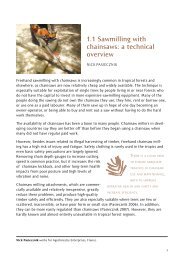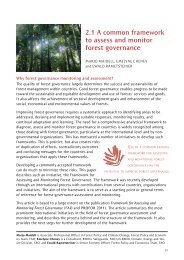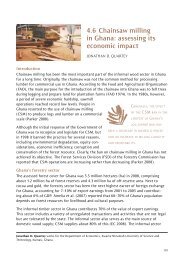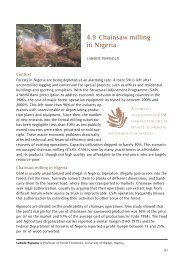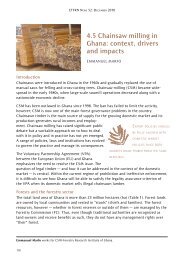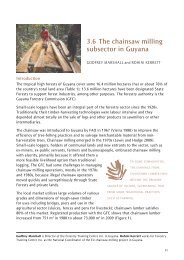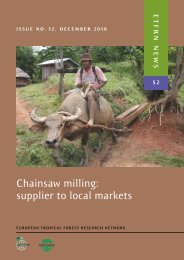Chainsaw milling: supplier to local markets - European Tropical ...
Chainsaw milling: supplier to local markets - European Tropical ...
Chainsaw milling: supplier to local markets - European Tropical ...
You also want an ePaper? Increase the reach of your titles
YUMPU automatically turns print PDFs into web optimized ePapers that Google loves.
3.7 chaiNsaw milliNg iN ThE caRibbEaN<br />
in the Dominican republic, chainsaw <strong>milling</strong> is rare. The country has a long tradition of<br />
using small band mills <strong>to</strong> convert logs in<strong>to</strong> lumber. <strong>Chainsaw</strong> <strong>milling</strong> is mostly associated<br />
with illegal harvesting of valuable broad-leaf species such as<br />
mahogany.<br />
Forest harvesting in Cuba is practised and well regulated by<br />
state companies in the form of traditional logging operations.<br />
<strong>Chainsaw</strong>s are often not available for purchase by<br />
individuals so chainsaw <strong>milling</strong> is limited. it can be assumed,<br />
however, that some chainsaw <strong>milling</strong> is carried out, despite<br />
the fact that it is illegal. it is not considered a major problem<br />
by the Cuban forest authorities.<br />
chainsaw <strong>milling</strong> and the market<br />
most chainsaw opera<strong>to</strong>rs in the Caribbean cut lumber according<br />
<strong>to</strong> a specific order from a <strong>local</strong> buyer, for example, a carpenter or a person building<br />
a house. after securing the order the opera<strong>to</strong>r goes in<strong>to</strong> the forest, identifies a tree<br />
and purchases it from the forestry department. The tree may contain far more timber<br />
than the order requires and the excess material is often left in the forest <strong>to</strong> rot.<br />
most chainsawn lumber is being sold soon after it is cut; very few chainsaw millers have<br />
the patience or the resources <strong>to</strong> stack the lumber <strong>to</strong> dry. The fact that the wood is green<br />
and often unevenly cut contributes <strong>to</strong> the perception that <strong>local</strong>ly produced lumber is of<br />
inferior quality. in general the price of chainsawn lumber is 10–30% below the price of<br />
imported lumber.<br />
The distance <strong>to</strong> the nearest forest track or location accessible by a vehicle is key <strong>to</strong> profitability.<br />
in general, chainsaw <strong>milling</strong> in the islands is limited <strong>to</strong> areas within one km of the<br />
loading point. The greater the distance, the less interested the opera<strong>to</strong>r is in buying trees.<br />
it is difficult <strong>to</strong> assess the economic value of chainsaw production in the islands because<br />
the sec<strong>to</strong>r is very small and often part of the shadow economy (box 3). in addition, Csm<br />
is often associated with illegal activities, which are not recorded.<br />
Box 3. potential value of chainsaw <strong>milling</strong>: an example from Dominica<br />
Dominica has a forest cover of approximately 40,000 ha. only 6,000 ha are<br />
suitable for forest management and harvesting; the remainder is protection forest.<br />
assuming a conservative growth rate of one m3 per year per hectare, the forest<br />
could sustainably provide 6,000 m3 of harvestable wood or approximately 2,400 m3 of chainsawn lumber. This is equal <strong>to</strong> approximately 1,017,600 bm. based on a <strong>local</strong><br />
price for chainsawn lumber of us$1 per bm, this represents a value of more than<br />
us$1 million.<br />
103



